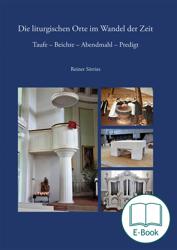From antiquity to the present, the theological and art-historical development of the places where the sacraments of baptism, confession and the Lord's Supper are administered and the sermon is presented on 300 pages and with over three hundred images. The archaeological and arthistorical highlights are used as examples, but also simple, folk designs are used. The book is aimed at readers who are interested in an overview, be they clergy, because they work in these places or because they will work in them as students, be they church visitors who, for their part, want to put what they in history see and marvel often enough.
The development of the liturgical places in the church is told across time and denominations on 300 pages and with over three hundred pictures. Altar, pulpit, baptismal font and confessional are visible expressions of the Lord's Supper, sermon, baptism and confession. In the Protestant Church they are referred to as the four means of grace, in the Catholic Church there are four of the seven sacraments. If one looks at the liturgical places from antiquity to the present, they are not only subject to a formal change, but they also reflect the changes in the actions performed on them due to the history of theology. Among the objects cited as examples, many are named that have also found their way into art history, but also those that have not aroused the interest of art historians in simple village and country churches. But wherever they are to be found, they are testimonies of preaching and faith that have become form and image, sometimes highly complex, sometimes simple and popular. While examples in the area of the Roman Empire are used for the early Christian development, the selection concentrates on Central Europe and the German-speaking area as time progresses.
In this sense, the book is aimed at readers who are interested in an overview, be they clergy, because they work in these places or because they will work in them as students, be they church visitors who, for their part, want to be part of history what they see and marvel at often enough. It is at the same time a contribution to the iconography of Protestant and Catholic statements of faith, because the liturgical places themselves explain in words and pictures the faith that is proclaimed and carried out in them. At the same time, they give an insight into the execution of the liturgy in their respective time with contemporary images.
„[…] Das Buch empfiehlt sich nicht nur mit Blick auf den protestantischen Kirchenraum, sondern auch auf den katholischen. Denn die Darstellung nimmt die vor- wie nachreformatorischen Entwicklungen auf und zeigt Beziehungen sowie gegenseitige Bedingungen konfessioneller Prägungen auf. […] Besonders beachtenswert sind die Kapitel zu Beichtorten und Kanzeln, die eine hilfreiche Übersicht bieten. Mit vier kleineren Kapiteln schtießt das Buch
und befragt die liturgischen Orten nach ihrem Bezug zur Gemeinde, weist ikonographische Gesetzmäßigkeiten
aul blickt auf liturgisches Handeln außerhatb des Kirchenraums und stettt die Frage, wieweit die ,,Heitigkeit
der Gnadenmittel" durch die liturgischen Orte verdeutlicht wird. lm Anhang finden sich Anmerkungen,
ein kapitelweise gegliedertes Verzeichnis wichtiger Literatur sowie der Bitdnachweis mit lnternetlinks. ,,Den
Often der Spendung der Gnadenmittel eine neue Aufmerksamkeit zu schenken" (S. foo), diesen Wunsch
erlütlt Sörries Buch für mich ohne Zweifel.“
Von Christoph Schmitt
In: Kirchenpädagogik, Ausgabe 22, S. 57
Reiner Sörries, * 1952 in Nuremberg, is a theologian, Christian archaeologist and art historian, associate professor for Christian archeology and art history in the theology department of the University of Erlangen. From 1991 to 2015 he was director of the Museum for Sepulchral Culture in Kassel. Retired since 2016, he lives in Kröslin on the Baltic Sea.


 Sample
Sample